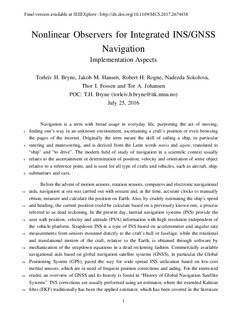Nonlinear observers for integrated INS\/GNSS navigation: implementation aspects
| dc.contributor.author | Bryne, Torleiv Håland | |
| dc.contributor.author | Hansen, Jakob Mahler | |
| dc.contributor.author | Rogne, Robert Harald | |
| dc.contributor.author | Sokolova, Nadezda | |
| dc.contributor.author | Fossen, Thor I. | |
| dc.contributor.author | Johansen, Tor Arne | |
| dc.date.accessioned | 2018-01-29T10:41:10Z | |
| dc.date.available | 2018-01-29T10:41:10Z | |
| dc.date.issued | 2017 | |
| dc.identifier.citation | IEEE Conference on Control Technology and Applications, 2017, 37 (3), 59-86. | nb_NO |
| dc.identifier.issn | 1066-033X | |
| dc.identifier.uri | http://hdl.handle.net/11250/2480223 | |
| dc.description.abstract | Navigation is a term with broad usage in everyday life and can mean the act of moving, moving through an unknown environment, ascertaining a craft's position, or even browsing on the Internet. Originally, the term meant the skill of sailing a ship, in particular steering and maneuvering, and is derived from the Latin words navis and agere, meaning "ship" and "to drive." The modern field of study of navigation in a scientific context usually relates to the ascertainment or determination of position, velocity, and orientation of some object relative to a reference point and is used for all type of crafts and vehicles, such as aircraft, ships, submarines, and cars | nb_NO |
| dc.language.iso | eng | nb_NO |
| dc.title | Nonlinear observers for integrated INS\/GNSS navigation: implementation aspects | nb_NO |
| dc.type | Peer reviewed | nb_NO |
| dc.type | Journal article | nb_NO |
| dc.source.pagenumber | 59-86 | nb_NO |
| dc.source.volume | 37 | nb_NO |
| dc.source.journal | IEEE Conference on Control Technology and Applications | nb_NO |
| dc.source.issue | 3 | nb_NO |
Tilhørende fil(er)
Denne innførselen finnes i følgende samling(er)
-
SINTEF Digital [2501]
